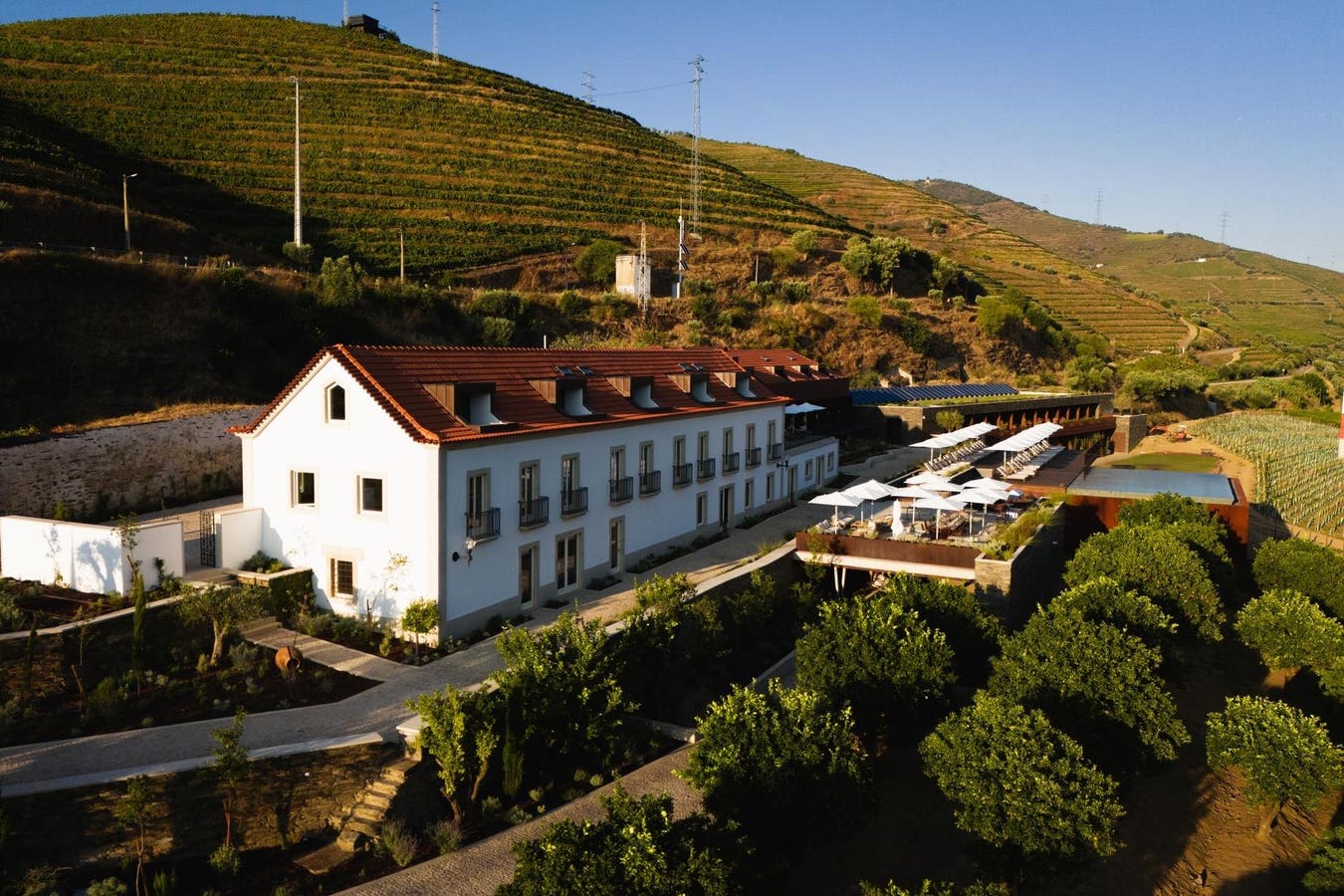Torel Quinta da Vacaria
Courtesy of the hotel
“The scenery does the work for us,” says Márcio Faria Dias, the hotel manager of Torel Quinta da Vacaria in Portugal’s dramatic Douro Valley. The whole place is based on what he calls “a way of silence”—to slow down, to disconnect, to relax in the spa, to enjoy some increasingly sought-after wines.
The hotel, which opened a little less than one year ago, stands at something of a gateway to the most magnificent parts of the terraced Douro Valley, a UNESCO World Heritage Site and the oldest demarcated wine region in the world. It’s easily reached by highway or train from Porto—none of the hairpin turns that are needed to access some of the more remote reaches of the valley—but also deep enough in to have the sort of scenery that can do the work of attracting international visitors.
Of course, that scenery gets some skilled assists. The structure, which combines two existing manor houses (one of which dates from the 17th century, and the other of which is painted port-wine red in a nod to the location) with a new semi-underground schist building, is the work of Porto-area architect Luís Miguel Oliveira. The grounds were enhanced by landscape architect João Bicho, who aimed to preserve the region’s native flora and create a space that’s impactful without becoming too exotic or manicured.
A hotel terrace
LUIS FERRAZ
The design of the 33 guest rooms, two restaurants, vinotherapy spa, bar and other public spaces is by Studio Astolfi. Lisbon-based designer Joana Astolfi is known for the deft mixture of old and new she installs in projects including Michelin-star restaurants, luxury retail and posh private residences.
Here, she brings her signature spirit of play to spaces that feel warm and familiar, deconstructing Portuguese heritage, winking with old toys and tools, and using sly humor to avoid stating the obvious. Silhouettes are rounded to match the curvaceous hills outside, and the color palette emphasizes the blue of the river, the green of the vines and the dark red of their juice.
The fact that this contemporary spirit glimmers in a region—the oldest of its kind in the world, as they like to remind us—that’s steeped in tradition makes Torel Quinta da Vacaria noteworthy. But it’s also somewhat par for the course for the hotel’s management brand. The new property is part of the Torel Boutiques collection of small five-star hotels in Portugal; they’re known for combining grand heritage with striking design.
A guest suite
LUIS FERRAZ
The group also prides itself on its high service standards, and Quinta da Vacaria is no exception. Dias, who grew up nearby before attending hotel school in Switzerland and working in luxury hospitality in far-flung locales from Thailand to St. Barth, is clear that he’s not aiming for “white glove service, like at the Ritz in Paris.”
That wouldn’t make any sense here. What the hotel offers instead is an approach that’s familiar rather than formal, with a young team that’s 80% from the immediate area and almost entirely Portuguese. “They bring a genuine hospitality that makes up for the lack of formal training,” says Dias, though only a stickler would complain about a lack of precision in a place with as much rural beauty as this one.
In fact, it’s hard to discern any lack of precision at the hotel’s fine dining restaurant, another first in the area. The seven-table Schistó opened in March under the leadership of Vitor Matos, Michelin’s favorite Portuguese chef. Two of his five stars are at restaurants within other Torel hotels, and they aren’t shy about the fact that they’re aiming for another one here.
Schistó
LUIS FERRAZ
They’ve put the fully open kitchen the center of the dining room, as is fashionable these days, and they’ve fashioned a ten-“moment” tasting menu based on super-local ingredients: cheese from nearby Régua, vegetables and citrus from the onsite gardens, meat from local farmers, and freshwater fish and eel from the Douro and Corgão Rivers. Those moments change all the time, and they hand out signed menus at the end of each evening rather than promising any signature plates.
Both in the pairing there and on the menu in the bar and in the casual, all-day restaurant, 16 Légoas (so named for its distance upriver from Porto, using an old wine-business unit of measure), all the wines come from Quinta da Vacaria. Dias admits this is a “bold bet,” but insists that it’s a bet worth making, both because it’s a point of difference—no other five-star boutique hotel in the valley produces its own wine at all—and because the winery’s nearly two dozen references are up to the job.
The quinta’s winemaking endeavors pre-date the valley’s demarcation, which was done in the 18th century. A few historical artifacts around the property still reference its origins, in the year 1616. But the winery itself now occupies another new building, just up the hill from the hotel, a welcome addition the region’s wine-tourism circuit. There, the tours include the usual tastings—including at a long table in a glass-walled room above the aging barrels—and a visit to a well-done little winemaking museum. They also organize private wine lunches in small glass houses above and among the vineyards.
One of the winery’s glass houses for private lunches
Luis Ferraz
While the hilltop house has impressive, wide-angle views over the Douro Valley, the hotel organizes excursions that give guests a close-up on the river below. They have a partnership with the local company Marma Slow, which has a collection of vintage wooden boats (imagine Italian Rivas but hand-built in Portugal), to take guests on slow-going river cruises. It’s a stripped-down sort of luxury, and a welcome contrast to some of the bling that’s happening nearby, and another case of letting the magnificent scenery speak for itself.
MORE FROM FORBES
